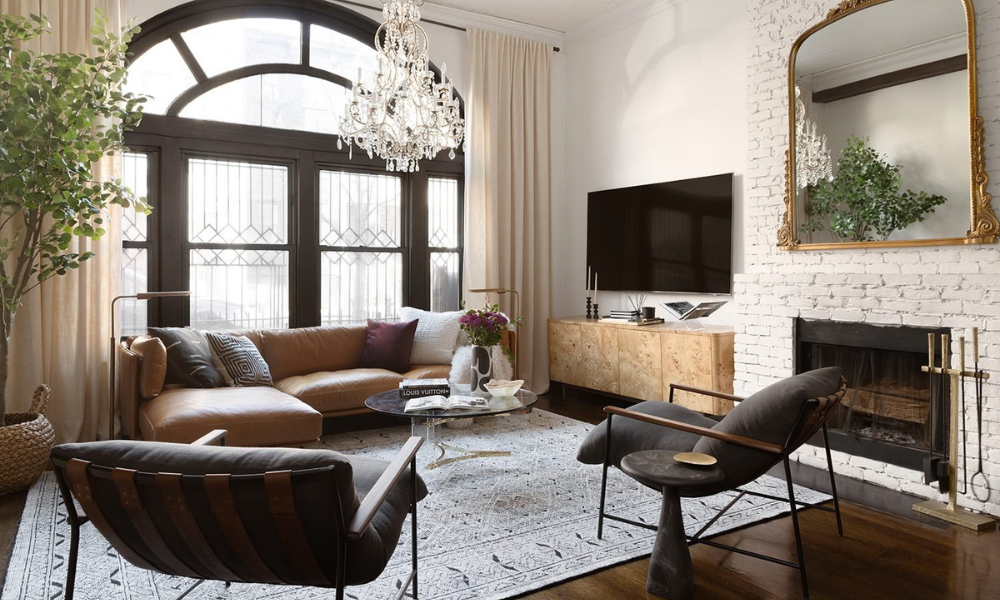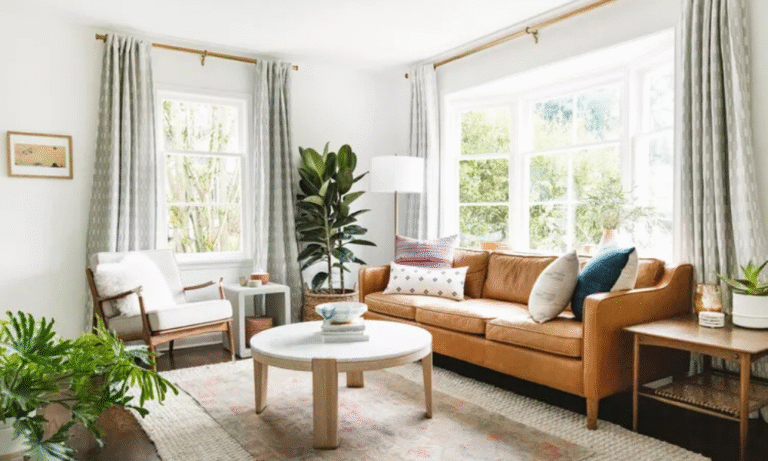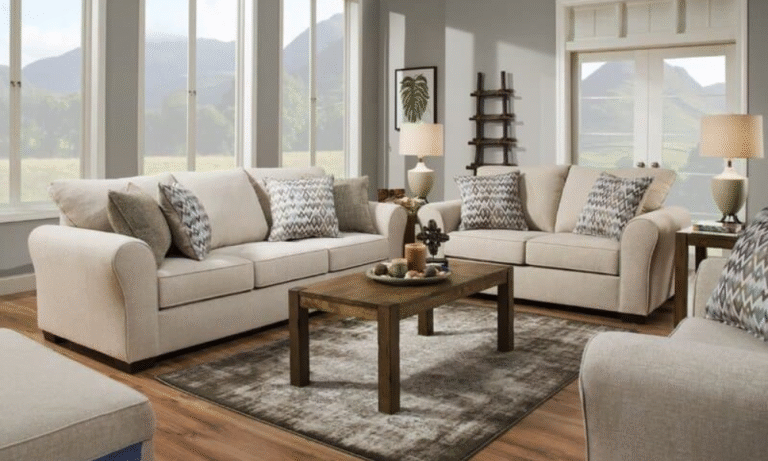Estimated reading time: 13 minutes
Last updated on August 21st, 2025 at 05:19 am
Are you struggling to make the most of your small living room? Don’t worry, you’re not alone. Many homeowners face the challenge of creating a functional and visually appealing space in limited square footage.
The good news is that with some smart planning and strategic design choices, you can set up a small living room that feels spacious and inviting.
In this comprehensive guide, we will walk you through the process of maximizing space and style in your small living room. From furniture arrangement to color schemes, we’ve got you covered!
How do you Set up a Small Living Room?
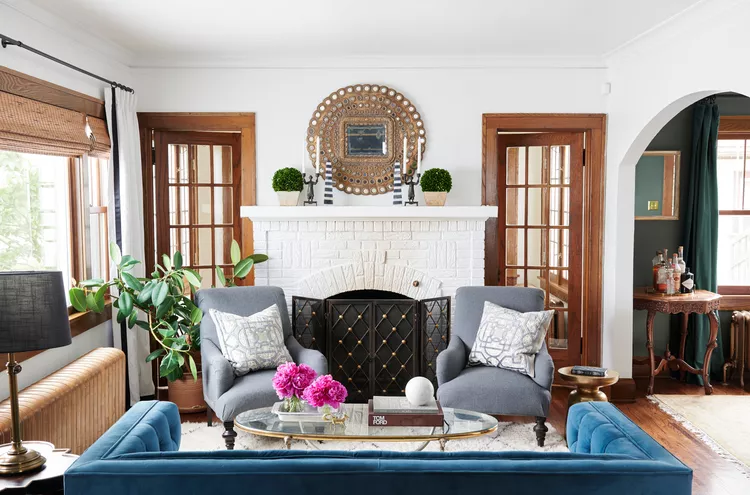
Photo Credit: hgtv
Setting up a small living room requires careful consideration and a thoughtful approach. With limited space, every square inch counts, and it’s essential to make the most of what you have. Here are some expert tips to help you set up your small living room in the best possible way:
Start with a Plan
Before diving into furniture shopping or rearranging your existing pieces, start by creating a plan for your small living room. Measure the dimensions of the space and make note of any architectural features such as windows, doors, or built-in elements.
Consider the traffic flow and how you envision using the room. Having a clear plan will help you make informed decisions when it comes to furniture selection and placement.
Choose the Right Furniture
When it comes to furniture for a small living room, less is often more. Opt for pieces that are appropriately scaled to the size of your room. Look for furniture with slim profiles and clean lines to create a sense of openness.
Consider multifunctional furniture, such as a sofa with built-in storage or a coffee table with hidden compartments. This way, you can maximize functionality without sacrificing space.
Arrange Furniture Strategically

Photo Credit: houzz
Proper furniture arrangement is key to maximizing space in a small living room. Start by placing the largest piece of furniture, such as the sofa, against the longest wall to create a focal point.
Arrange additional seating around this focal point, ensuring there is enough space for comfortable movement.
Avoid blocking pathways or crowding the room with too much furniture. Be mindful of traffic flow and aim for a layout that promotes easy conversation and accessibility.
Embrace Vertical Space
When floor space is limited, it’s essential to make use of vertical space. Install shelves or wall-mounted cabinets to provide extra storage for books, decor, or media equipment.
This not only frees up valuable floor space but also draws the eye upward, creating the illusion of height.
Decorate the shelves with items that reflect your personal style, but be mindful of clutter. A clutter-free environment will make your small living room feel more spacious and organized.
Let There Be Light
Lighting plays a crucial role in setting up a small living room. Maximize natural light by keeping window treatments minimal or using sheer curtains that allow light to filter through. Consider adding mirrors strategically to reflect light and create the illusion of a larger space.
In terms of artificial lighting, opt for a mix of ambient, task, and accent lighting to create depth and enhance the atmosphere. A well-lit room not only feels more spacious but also adds a touch of elegance and warmth.
Choose a Cohesive Color Scheme
A well-chosen color scheme can work wonders in a small living room. Opt for light, neutral colors such as whites, creams, and pastels to create an airy
Create an Illusion of Space with Mirrors
Mirrors are a powerful tool when it comes to visually expanding a small living room. Strategically placing mirrors on the walls can reflect light and create the illusion of depth, making the room feel larger and more open.
Consider hanging a large mirror opposite a window to maximize the natural light bouncing around the room. You can also experiment with mirrored furniture or decorative accents to enhance the effect.
Utilize Dual-Purpose Furniture
In a small living room, it’s essential to make every piece of furniture count. Look for dual-purpose furniture that serves multiple functions to maximize your space. For example, an ottoman with hidden storage can act as both a footrest and a place to store blankets or magazines.
A compact desk can double as a console table when not in use. By investing in versatile furniture, you can optimize functionality without compromising on style.
Opt for Light-Colored Flooring

Photo Credit: barlinek
The color of your flooring can significantly impact the perceived size of your living room. Light-colored floorings, such as light wood or pale tiles, can create a sense of openness and airiness.
Lighter floors reflect more light, making the room appear brighter and more spacious. Additionally, consider using a rug with a light color or a subtle pattern to further enhance the illusion of space.
Embrace Vertical Storage Solutions
When floor space is limited, think vertically. Utilize your walls for storage by installing shelves, floating cabinets, or wall-mounted bookcases. Vertical storage solutions not only provide additional space for your belongings but also draw the eye upward, making the room feel taller.
Get creative with your wall storage and showcase decorative items or personal mementos to add personality to your small living room.
Use Strategic Room Dividers
If your small living room serves multiple purposes, such as a living and dining area combined, consider using room dividers to create distinct zones. Folding screens, bookcases, or curtains can be used to visually separate different areas while maintaining an open and cohesive feel.
These dividers not only provide privacy and functionality but can also act as design elements, adding texture and interest to your living room.
Optimize Natural Light
Maximizing natural light is key to creating an inviting and spacious atmosphere in a small living room. Keep windows clear of heavy drapes or bulky blinds that block light. Instead, choose lightweight curtains or sheer fabrics that allow natural light to filter through.
If privacy is a concern, consider frosted window film or adjustable blinds that can be opened during the day. Harnessing the power of natural light will make your living room feel fresh, airy, and more expansive.
Declutter Regularly
Clutter is the enemy of a small living room. Regularly decluttering and organizing your space is essential to maintaining a clean and spacious environment. Take a minimalist approach and only keep items that serve a purpose or bring you joy.
Invest in stylish storage solutions such as baskets, bins, or decorative boxes to keep everyday items out of sight. By decluttering regularly, you’ll create an atmosphere of calmness and serenity in your small living room.
Incorporate Smart Technology
In today’s digital age, integrating smart technology into your small living room can enhance both functionality and style. Consider investing in a wall-mounted TV or a sleek entertainment unit to save space.
Smart lighting systems allow you to control the ambiance with a touch of a button. Additionally, wireless speakers and smart home assistants can seamlessly blend into your decor, providing convenience and entertainment without taking up valuable space.
Opt for Multi-functional Lighting Fixtures
When choosing lighting fixtures for a small living room, prioritize multi-functional options that serve both practical and decorative purposes. For example, pendant lights with adjustable height can provide task lighting when lowered for activities such as reading, and serve as stylish statement pieces when raised.
Wall sconces with adjustable arms can be directed to highlight specific areas or artworks. By selecting lighting fixtures that offer versatility, you can maximize the functionality and aesthetics of your small living room.
Use Light and Airy Window Treatments
Window treatments can greatly influence the ambiance of a small living room. To create an open and spacious feel, opt for light and airy curtains or blinds. Sheer fabrics allow natural light to filter through while providing a touch of privacy.
Avoid heavy drapes that can weigh down the room and make it feel smaller. Choose window treatments that complement your color scheme and let the beauty of your windows shine through.
Play with Scale and Proportions
In a small living room, it’s important to strike a balance between furniture scale and room proportions. Avoid oversized furniture that overwhelms the space and opt for pieces that are appropriately sized.
Look for sofas and chairs with narrower arms and legs, as they create a more visually open and streamlined appearance. Don’t be afraid to mix and match furniture styles and sizes to add visual interest while maintaining harmony in your small living room.
Create a Focal Point
A well-defined focal point can anchor a small living room and draw attention away from its size. It can be a fireplace, a piece of artwork, or even a well-styled media console. By directing the focus toward a specific area, you can create a sense of purpose and visual appeal.
Choose a focal point that reflects your style and personality, and arrange furniture and decor around it to enhance the overall impact.
Incorporate Reflective Surfaces
Mirrored and reflective surfaces can work wonders in a small living room. Consider adding a mirrored coffee table or side table to create a sense of depth and bounce light around the room.
Reflective surfaces, such as glass or metal accents, can add a touch of sophistication while amplifying the perception of space. Be mindful of placement to ensure that the reflections enhance the overall aesthetic and don’t create visual clutter.
Experiment with Bold Accents
While it’s generally advised to keep the overall color palette light and neutral in a small living room, don’t shy away from incorporating bold accents to add personality and visual interest. Introduce pops of color through throw pillows, rugs, or artwork.
Choose a vibrant accent wall or bold-patterned curtains to create a focal point. By strategically incorporating bold elements, you can infuse energy and character into your small living room without overwhelming the space.
Consider Open Shelving
Open shelving can be an effective way to display your favorite books, decorative items, or collectibles while avoiding a cluttered look. Opt for floating shelves or wall-mounted units to save floor space and create a sense of openness.
Arrange items in an organized and visually pleasing manner, using a mix of textures, shapes, and colors to create a curated display. Open shelving can not only serve as storage but also as a design feature in your small living room.
Don’t Neglect the Ceiling
The ceiling is often an overlooked element when setting up a small living room, but it can play a significant role in creating an illusion of space. Consider painting the ceiling a lighter color than the walls to make it appear higher.
Alternatively, you can add architectural interest with crown molding or ceiling medallions to draw the eye upward. These subtle touches can contribute to a sense of expansiveness and add
Add Natural Elements

Photo Credit: planner5d
Bringing in natural elements can create a sense of freshness and tranquility in your small living room. Incorporate plants, such as potted succulents or hanging vines, to add a touch of greenery and improve air quality.
Natural materials like woven baskets, rattan furniture, or wooden accents can add warmth and texture. By connecting with nature, you can create a harmonious and inviting atmosphere in your small living room.
Utilize Nooks and Corners
Make the most of every nook and corner in your small living room. Transform underutilized spaces into functional areas by adding a cozy reading nook, a small workspace, or a mini bar cart. Use corner shelves or built-in cabinets to maximize storage opportunities.
By optimizing these overlooked areas, you can create additional functionality and make your small living room feel more complete.
Embrace Minimalism
A minimalist approach can work wonders in a small living room. Embrace simplicity and declutter to create a clean and streamlined space. Keep furniture and decor to a minimum, focusing on quality over quantity.
Opt for a few carefully curated pieces that bring joy and purpose to the room. Emphasize clean lines, uncluttered surfaces, and a neutral color palette to create a serene and visually spacious environment.
FAQs about Setting Up a Small Living Room
Making a small living room cozy is all about creating a
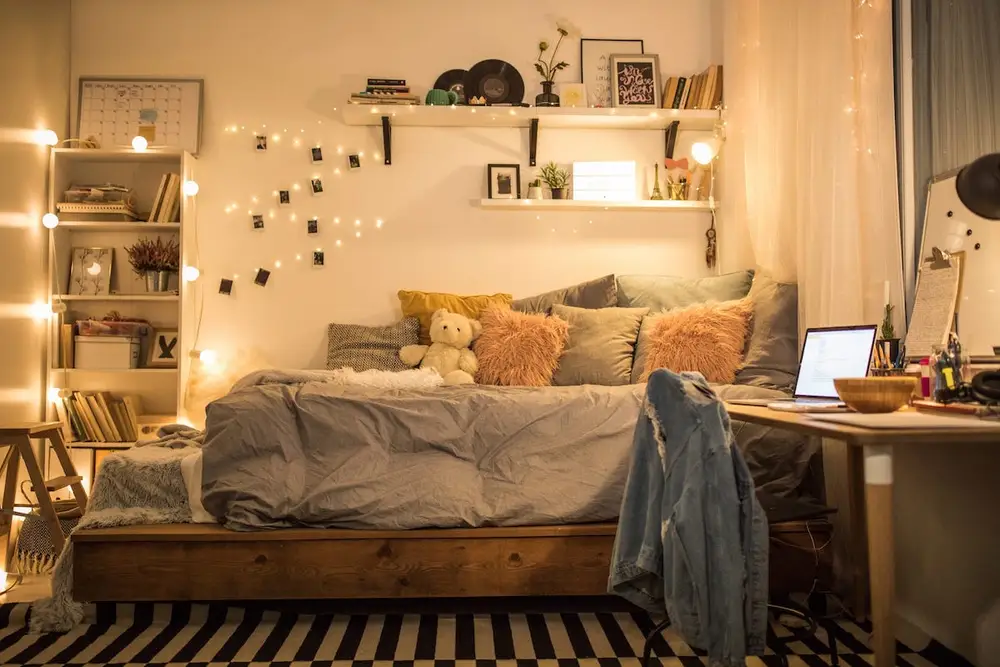
Photo Credit: insider
Use Cozy Textiles
Incorporating cozy textiles is a great way to add warmth and comfort to a small living room. Choose soft throw blankets, plush rugs, and cushions to create a cozy atmosphere. Opt for fabrics like velvet or faux fur for a luxurious touch.
Layering textures and using warm color tones can make the space feel inviting and snug. By adding these cozy textiles, you can transform your small living room into a comfortable retreat.
Hang Artwork Strategically
Artwork can elevate the aesthetic appeal of a small living room. Choose pieces that speak to your personal style and complement the overall decor. When hanging artwork, consider the scale and placement.
Hang larger pieces at eye level to draw the gaze upward and create a sense of verticality. Group smaller artworks together to make a statement gallery wall. By strategically hanging artwork, you can add visual interest and personality to your small living room.
Incorporate Flexible Seating
Flexibility is key when it comes to seating in a small living room. Opt for furniture pieces that can easily be rearranged or moved when needed. Consider using ottomans that can serve as both seating and footrests.
Poufs or floor cushions can provide additional seating options without taking up much space. Folding chairs or stools can be stored away when not in use. Having flexible seating arrangements allows you to adapt the room to different needs and maximize the available space.
Introduce Accent Lighting
In addition to general lighting, incorporating accent lighting can create a cozy ambiance in your small living room. Use table lamps, floor lamps, or wall sconces to add layers of lighting and create a warm and inviting atmosphere.
Dimmer switches can provide control over the intensity of the light, allowing you to set the desired mood. By incorporating accent lighting, you can create a cozy and relaxing environment in your small living room.
Add Personal Touches
To make your small living room truly feel like home, don’t forget to add personal touches. Display cherished photos, mementos, or artwork that hold sentimental value. Showcase items that reflect your hobbies or interests. Incorporate items collected from travels or family heirlooms that tell a story. By infusing your personality into the space, you can create a warm and inviting atmosphere that is uniquely yours.
Bottom Line
Setting up a small living room can be a rewarding challenge. By applying the right design principles, utilizing space-saving strategies, and incorporating creative solutions, you can transform your small living room into a functional and stylish space that feels open and inviting.
Remember to prioritize functionality, maximize natural light, and create a sense of balance and harmony. With careful planning and attention to detail, you can create a small living room that is not only visually appealing but also reflects your personal style and meets your everyday needs.
